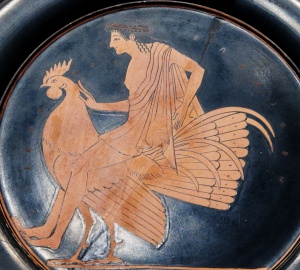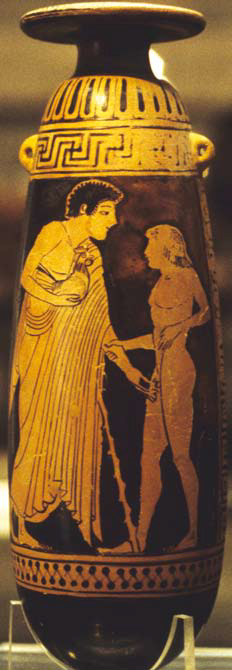(Boylove Documentary Sourcebook) - On the Masculine and Sexual Symbolism of the Fighting Cock as a Traditional Pederastic Love Gift in Ancient Greece: Difference between revisions
m Dandelion moved page (BLSB) - On the Masculine and Sexual Symbolism of the Fighting Cock as a Traditional Pederastic Love Gift in Ancient Greece to (Boylove Documentary Sourcebook) - On the Masculine and Sexual Symbolism of the Fighting Cock as a Traditional Pederastic Love Gift in Ancient Greece |
|||
| (2 intermediate revisions by the same user not shown) | |||
| Line 25: | Line 25: | ||
[...] | [...] | ||
In most parts of the world cockfighting is a sport practised exclusively by adult males, but in Greece the sport was ideally represented as a pastime for adolescent boys, and particularly young aristocrats. We have seen that in Greek art the human figures associated with fighting cocks are boys, and mostly adolescent boys. Language also encouraged a close identification between the adolescent and the cock. Cocks were, like their owners, ‘aristocrats’; fighting cocks were termed ‘noble’, those unfit for sport ‘ignoble’ or ‘vulgar’. The harsh sounds made by an adolescent whose voice is breaking are referred to as crowing, <i>kokkusmos</i> (<i>gallulare</i> in Latin). And while words for ‘cock’ and ‘penis’ are homonymous in the vernacular of a great many languages, the Greek equivalent, <i>koko</i>, is only ever used as a ‘pet name’ for the puerile member. The close almost exclusive identification of fighting cocks with élite adolescents is hard to square with a tale about martial valour, an express concern of all Greek males. Rather, it reflects the particular configuration of male homosexuality in Classical Greece with its emphasis on [[Pederasty in ancient Greece|pederasty]] and its predominantly aristocratic milieu. | In most parts of the world cockfighting is a sport practised exclusively by adult males, but in Greece the sport was ideally represented as a pastime for adolescent boys, and particularly young aristocrats. We have seen that in Greek art the human figures associated with fighting cocks are boys, and mostly adolescent boys. Language also encouraged a close identification between the adolescent and the cock. Cocks were, like their owners, ‘aristocrats’; fighting cocks were termed ‘noble’, those unfit for sport ‘ignoble’ or ‘vulgar’. The harsh sounds made by an adolescent whose voice is breaking are referred to as crowing, <i>kokkusmos</i> (<i>gallulare</i> in Latin). And while words for ‘cock’ and ‘penis’ are homonymous in the vernacular of a great many languages, the Greek equivalent, <i>koko</i>, is only ever used as a ‘pet name’ for the puerile member. The close almost exclusive identification of fighting cocks with élite adolescents is hard to square with a tale about martial valour, an express concern of all Greek males. Rather, it reflects the particular configuration of male [[homosexuality]] in Classical Greece with its emphasis on [[Pederasty in ancient Greece|pederasty]] and its predominantly aristocratic milieu. | ||
</div> | </div> | ||
| Line 57: | Line 57: | ||
*[https://greek-love.com/antiquity/greek-practices/greeks-pedicate-loved-boys-pederasty DID THE GREEKS PEDICATE THEIR LOVED BOYS? (Greek Love Through the Ages)] | *[https://greek-love.com/antiquity/greek-practices/greeks-pedicate-loved-boys-pederasty DID THE GREEKS PEDICATE THEIR LOVED BOYS? (Greek Love Through the Ages)] | ||
[[Category:Boylove Sourcebook]] | [[Category:Boylove Documentary Sourcebook]] | ||
[[Category:Reference material on ancient Greece]] | [[Category:Reference material on ancient Greece]] | ||
[[Category:Sexuality]] | [[Category:Sexuality]] | ||
Latest revision as of 11:24, 3 November 2021

From "The Cultural Poetics of the Greek Cockfight" by Eric Csapo, in The Australian Archaeological Institute at Athens Bulletin, Vol. 4 (2006/2007). Footnotes omitted.
In antiquity, the cock, like the sphinx, was a liminal creature. Its habit of crowing at dawn made it a symbol of transition from night to day and darkness to light. As a marker of time and transitions, it is associated with birth, death and rebirth, and thus gains a close association with liminal deities such as Leto, Hermes, Demeter/Persephone and Asclepius. Adolescence was also closely connected to death and rebirth: Artemidorus, the dream interpreter, claims that dreams about adolescence signify marriage for the bachelor and death for the aged (1.54).
[...]
In myth, the cock is closely connected with the war-god, Ares. Originally the cock was a human companion of Ares named Alectryon, which is simply the Greek word for ‘cock’. At first, however, there was nothing martial about Alectryon. Before becoming a cock, Alectryon is said by Lucian to have been ‘an adolescent boy, beloved of Ares, who kept company with the god at drinking parties, caroused with him, and was his companion in lovemaking’. His only soldierly duty was to keep watch while Ares made adulterous love to Aphrodite, so as to prevent the rising sun from seeing them and from reporting the affair to Aphrodite’s husband Hephaestus. Alectryon failed to keep his post even in this lightest of all soldierly duties. He fell asleep and as a result Hephaestus learned of the affair and set the trap, so memorably described in Odyssey 8, that led to the public exhibition and humiliation of Ares and Aphrodite caught by invisible bonds in the love embrace. As punishment Ares turned Alectryon into a cock, adding, as penance, an ineluctable impulse to crow at the approach of the sun in eternal compensation for his failure to cry warning on that fateful night.
[...]
Cocks served as ready symbols for that supreme agon and most enduring theme of Greek art and poetry: WAR. In Aeschylus the expression ‘hearts of cocks’ stands metaphorically for the spirit of violent confrontation (Eum. 861). For this reason, cocks are a favourite motif on shield blazons. Programmatic decoration on Attic vase-painting frequently draws similes between fighting cocks and mythological combatants or hoplites (see, e.g., fig. 8).
[...]
The cock, as we noted, belongs not only to the realm of Ares, but is also close to Aphrodite. The epigrammatist Meleager took the cock on a grave stele to signal the dead man’s devotion to Aphrodite. Aristotle declares that chickens are ‘most given to Aphrodite’ (HA 488b4). Oppian thinks them sex-crazed beyond all known birds. This is partly justified by observation: Aristotle notes that chickens are the only animals, besides humans, whose mating habits are not seasonal or limited. Indeed they are less limited than humans.
[...]
Given the cock’s association with both sex and masculinity, it is not surprising that it was the preferred love gift given by mature men to beautiful youths (fig. 13). In Margaret Visser’s words ‘the cock expressed the sheer maleness of the couple, their virile aggressivity and energy’.
[...]
In most parts of the world cockfighting is a sport practised exclusively by adult males, but in Greece the sport was ideally represented as a pastime for adolescent boys, and particularly young aristocrats. We have seen that in Greek art the human figures associated with fighting cocks are boys, and mostly adolescent boys. Language also encouraged a close identification between the adolescent and the cock. Cocks were, like their owners, ‘aristocrats’; fighting cocks were termed ‘noble’, those unfit for sport ‘ignoble’ or ‘vulgar’. The harsh sounds made by an adolescent whose voice is breaking are referred to as crowing, kokkusmos (gallulare in Latin). And while words for ‘cock’ and ‘penis’ are homonymous in the vernacular of a great many languages, the Greek equivalent, koko, is only ever used as a ‘pet name’ for the puerile member. The close almost exclusive identification of fighting cocks with élite adolescents is hard to square with a tale about martial valour, an express concern of all Greek males. Rather, it reflects the particular configuration of male homosexuality in Classical Greece with its emphasis on pederasty and its predominantly aristocratic milieu.

See also
- Adult friend (dictionary)
- Age of attraction (dictionary)
- Athenian pederasty
- Boylove
- Cretan pederasty
- Ephebophilia
- Erastes
- Eromenos
- Greek love
- Historical boylove relationships in ancient Greece
- Loved boy (dictionary)
- Minor-attracted person (dictionary)
- Pedophilia
- Philosophy of ancient Greek pederasty
- Spartan pederasty
- Theban pederasty
- Young friend (dictionary)
External links
- The Cultural Poetics of the Greek Cockfight (Academia.edu)
- The Rooster | Gallus (Lucian of Samosata Wiki)
- On the Role of the Fighting Cock in Greek pederasty (Greek Love Through the Ages)
- PURSUIT AND FLIGHT BY SIR KENNETH DOVER (Greek Love Through the Ages)
- DID THE GREEKS PEDICATE THEIR LOVED BOYS? (Greek Love Through the Ages)